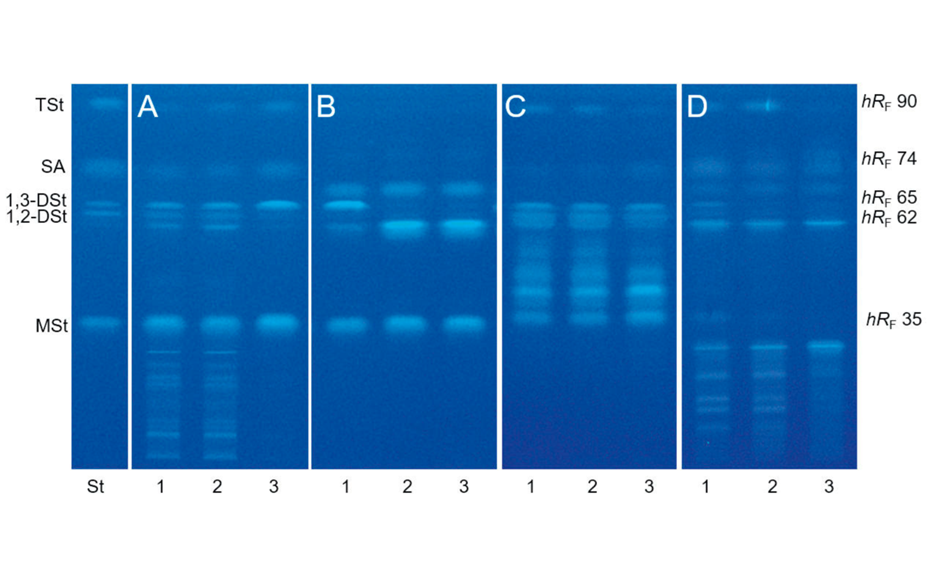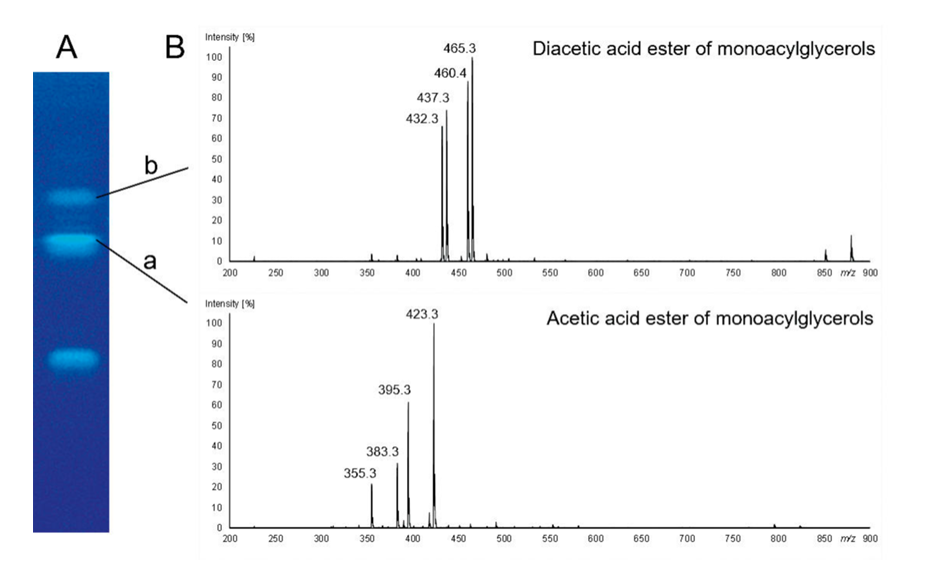
Authors: Prof. Dr. Michael Granvogl and Dr. Claudia Oellig Published in CBS 125
The development of straightforward and simple HPTLC methods for the characterization and determination of the food emulsifiers E471 and E472 in dairy products is one of the research topics of Dr. Claudia Oellig at the Department of Food Chemistry and Analytical Chemistry (170a); directed by Prof. Dr. Michael Granvogl (Institute of Food Chemistry, University of Hohenheim, Stuttgart, Germany). This study presents a method for the characterization of E472 emulsifiers by HPTLC fingerprints and the identification of separated constituents by mass spectrometry.
Introduction
Esters of fruit acids as well as mono- and diacylglycerols (MAG and DAG) are often used as additives in foodstuff to adjust its techno-functional properties. Due to their surface-active properties, they are listed as emulsifiers, more precisely as E472 food emulsifiers. They are usually added to food products to regulate stability and viscosity, and, for example in dairy products, to adjust foaming and emulsion stability. Regulation (EC) No 1333/2008 approves fruit acid esters of MAG and DAG as food additives and categorizes them into six groups based on the respective acids [1]. The main categories comprise acetic acid esters (ACETEM, E472a), lactic acid esters (LACTEM, E472b), citric acid esters (CITREM, E472c), and mono- and diacetyl tartaric acid esters (DATEM, E472e). These emulsifiers are very complex and widely varying mixtures of fruit acid esters of MAG and DAG, along with MAG, DAG, and further constituents. Because techno-functionality strongly depends on the emulsifier’s composition, reliable and easy to perform analytical methods are of great interest to control the product quality. In the presented characterization of E472, the cost-effective and efficient HPTLC provides fast results for many samples in parallel, wherein the fingerprint technique allows immediate visual evaluation of the samples [2].
The characterization of E472 food emulsifiers through HPTLC fingerprints was successfully developed and applied to several samples of the categories ACETEM (E472a), LACTEM (E472b), CITREM (E472c), and DATEM (E472e). After dissolving in tert-butyl methyl ether, emulsifiers were directly applied onto normal phase HPTLC silica gel and separated with a two-fold development. Derivatization with primuline allowed for visualization and easy comparison of fluorescent lipid classes under UV 366 nm. Coupling to mass spectrometry offers fast identification of prominent constituents of the complex emulsifier mixtures.
Sample and standard solutions
Samples of E472 emulsifiers (ACETEM, LACTEM, CITREM, and DATEM) are dissolved in tert-butyl methyl ether (tBME) at a concentration of 1 mg/mL. A standard-mix solution containing mono-, di-, tristearin, and stearic acid (MSt, DSt, TSt, and SA) is prepared at 0.125 μg/μL, respectively.
Chromatogram layer
HPTLC silica gel 60 F254s MS plates (Merck), 20 x 10 cm
Sample application
With the Automatic TLC Sampler (ATS 4) as 6.0 mm bands, 18 tracks, track distance 10.0 mm, distance from the left plate edge 15.0 mm, distance from the lower plate edge 8.0 mm, application volume 10.0 μL for samples and standard for visual characterization by fingerprint and 75.0 μL for samples for identification by mass spectrometry, drying in a fume hood for 10 m
Chromatography
In the Automatic Developing Chamber (ADC 2) with chloroform – methanol – water – formic acid 670:80:19:2 for the first development, migration distance 50 mm, drying time 10 min and with n-heptane – diethyl ether – formic acid 55:45:1 for the second development, migration distance 80 mm, drying time 5 min, plate activation for 5min at 33% using a saturated solution of magnesium chloride before each of the developments
Post-chromatographic derivatization
The plate is immersed into a solution of primuline (0.05% in acetone – water 4:1) with the Chromatogram Immersion Device (immersion speed 1 cm/s, immersion time 3 s) and dried for 5 min in a stream of warm air.
Documentation
With TLC Visualizer under UV 366 nm
Mass spectrometry
Zones are eluted with the TLC–MS Interface (oval elution head) at a flow rate of 0.2 mL/min with methanol – 0.1% formic acid 9:1 for 40 s into a single quadrupole mass spectrometer equipped with an electrospray ionization interface (positive ionization, scan mode).
Results and discussion
The visual characterization and comparison of E472 food emulsifiers were performed by the straightforward HPTLC fingerprint technique. Food emulsifiers were simply dissolved in tBME and directly used for HPTLC. A two-fold development on HPTLC silica gel with chloroform – methanol – water – formic acid 670:80:19:2 for the first development and n-heptane – diethyl ether – formic acid 55:45:1 for the second development offered suitable separation of the constituents for the investigated E472 categories. The fingerprint under UV 366 nm directly visualized differences between the categories and the complexity of the classes comprising numerous components. For the compounds of the lipid classes MSt, 1,2-DSt, 1,3-DSt, SA, and TSt, hRF values of 35, 62, 65, 74, and 90 were obtained. CITREM showed citric acid esters in the hRF range 0–35, ACETEM acetic acid esters in the hRF range 60–74, LACTEM lactic acid esters in the hRF range 35–62, and DATEM different fruit acid esters in the ranges 0–35 and 60–74. Thus, the fingerprint allows to distinguish between emulsifier categories and to determine variations within the same category of E472.
Direct hyphenation with mass spectrometry provided mass specific information and offered the identification of individual components. Thus, more detailed information on the emulsifier’s composition was obtained. Hence, the coupling to mass spectrometry offered the identification of prominent zones (components) of the categories and of zones (components) that differ in the visual fingerprint between batches or formulations. In addition, deviations in the emulsifier’s composition that might occur during storage can be identified.
In summary, the fingerprint technique is a fast tool to determine the emulsifier’s composition, and to relate differences in the composition to differences in the detected techno-functional properties and the dosage of emulsifiers in the product. In addition, this elegantmethod can be used for simple and efficient quality control of incoming commercial emulsifiers, for example in the dairy industry.

HPTLC fingerprint of E472 emulsifiers under UV 366 nm. Different batches (1–3) of (A) CITREM, (B) ACETEM, (C) LACTEM, and (D) DATEM with an amount of 10 μg emulsifier/zone and a (St) standard-mix containing MSt, 1,2-DSt, 1,3-DSt, SA, and TSt (1.25 μg/zone) for comparison.

PreviousNext
[1] The European Parliament and the Council of the European Union, Regulation (EC)No 1333/2008 of the European Parliament and of the Council of 16 December 2008 on food additives, 2008.
[2] Oellig et al., J Chromatogr A (2020) 460874.
Further information is available on request from the authors.
Contact: Dr. Claudia Oellig, Department of Food Chemistry and Analytical Chemistry (170a), Institute of Food Chemistry, University of Hohenheim, 70599 Stuttgart, Germany, claudia.oellig[at]uni-hohenheim.de
Download PDF
CBS 125: Characterization of E472 food emulsifiers by HPTLC fingerprintsPDF





